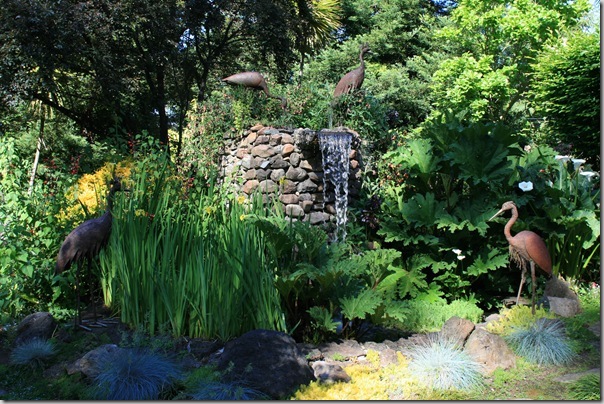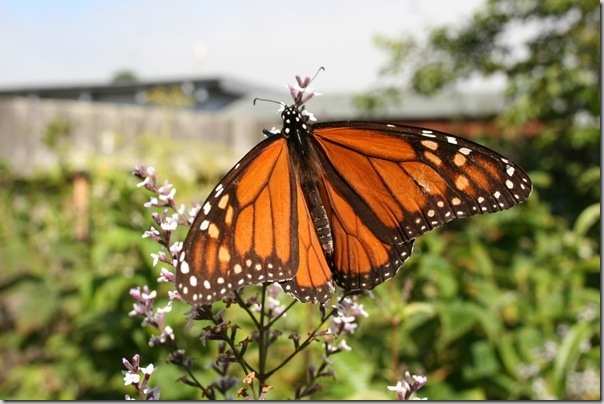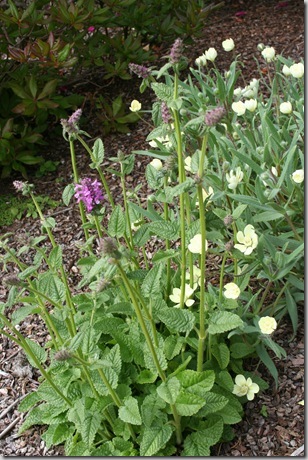For most of us, our first thought when designing a landscape is how to make an aesthetic difference. As landscape designers, we want to inspire people and give everyone who spends time in our landscape an opportunity to reflect, feel uplifted, and just enjoy the sheer beauty of the plants that share our world.
This is important work. I know when I spend even a few minutes in my garden, I emerge feeling refreshed and ready to do good things in the world. A life spent in the pursuit of beauty is a wonderful thing.
However, there’s more to the creation of beauty than pairing this color with that, and landscape designers and home gardeners are in a position to be able to make an enormous difference to the world simply by choosing some plants over others. I’m talking, of course, about native plants.
Native plants have a special relationship with the birds, butterflies, bugs and bees in our gardens. The plants native to your region are the ones that your local wildlife are adapted to eating, using as breeding grounds, and enjoying as habitat. While we may see some generalist species of birds and bugs enjoying nectar or raising young in our gardens, for other species that have evolved to need a specific plant (like most butterflies), the beautiful landscape plants from the regular nursery may as well be plastic.
Not only do native plants attract wildlife to our gardens (a type of beauty which hits me on a soul level), but they also ground us and connect us to our surroundings in a way that the same-old, same-old landscape plants just don’t. There’s something very jarring and wrong about seeing the same Astilbes, daylilies and roses in Arizona as you do in Washington. It’s like that weird time-space warp you experience when visiting a McDonald’s or a Wal-Mart. Once you get inside, they’re pretty much the same anywhere across our fine and diverse country. When I think about why I live where I do, “utter boring sameness” is not the attribute I’d pick.
However, most landscapers and gardeners think of themselves as artists. We love experimenting with color and texture, and telling an artist to limit their palette is never going to go over well, even if doing so invites a whole new element of beauty into the landscape in the form of salamanders, beetles, butterflies and birds.
So how does one go about making a real difference in the landscape, while still enjoying our human, artistic interaction with the space? If you’re not going to go all-native (and most people don’t), then it’s about how to make the biggest impact with the natives you do choose. Here’s how.
Cram them in!
In the book The New American Landscape (highly recommended), Douglas Tallamy suggests packing your native plants tightly within the landscape. There are some caveats to this approach, which I’ll get to, but I’ll start with the benefits.
 A dense planting provides shelter for birds (Zumba Garden, San Francisco Bay Area).
A dense planting provides shelter for birds (Zumba Garden, San Francisco Bay Area).
Woody shrubs: Stands of trees and woody shrubs are of immense benefit to birds looking for a place to nest, rustle about, and take shelter from storms. Let’s imagine you’re a bird, a storm is coming, and you need to find a place to bed down. Is that single specimen plant in the center of the garden the best place to make a home, or would you choose a thicket of shrubs and trees which better screen and protect you from the elements? That single Japanese maple in the center of the yard may make a nice summer home, but when it comes to raising young or seeking shelter, birds benefit much more from a thicker planting.
This is great news for plant geeks. You now have an excuse to plant just a hair closer than you might have otherwise (can you say “more plants”?), and to allow things to grow together in an exuberantly beautiful way. High-five for that!
Perennials and flowers: The same principle applies. While a low-maintenance landscape usually has a lot of mulch and a few flowers (which is good at the beginning when things are filling in), when plants are mature, it’s much better for wildlife if many of the plants touch. Not only does a full planting repel weeds (which are usually invasives with no benefit to wildlife), but it also provides a safe location for caterpillars to transform into butterflies, salamanders to eat bugs, and beetles to eat snails and slugs.
The caveats: Plants do wage chemical warfare on different varieties planted close to them (it’s called allelopathy), so if you’re going to plant things close together, it’s better to plant the same variety in masses, rather than do the busy-looking one-of-this-one-of-that type of scheme.
It’s also important to place plants properly if you’re going to plant them close together. Planting close enough that things grow together can stifle airflow (a good thing for birdies looking for a home), but a lack of wind rustling the leaves can also promote fungal disease if your plants aren’t happy. So with this planting style, don’t push the bounds of what the plant wants. If it wants full sun, don’t cram three of them into part shade to mold. You might be able to get away with it if you give them space, but with this technique, try to give them the conditions they prefer, so your plants will be as happy as the birds.
Choose host plants

We don’t fully understand all the ways in which our region’s plants interact with the wildlife and soil microbes in our gardens, since it can be tough to get research money to study things that don’t have an agricultural or other monetary benefit.
It is clear, however, that natives have a deeper interaction with wildlife than do plants from other places, and many caterpillars/ butterflies rely exclusively on specific native plants in order to survive. We call those plants “host” plants, because they’re needed at certain parts of the butterfly’s life cycle to host their transition from one type of beastie to another.
Ferreting out which specific plants will benefit our own local butterflies can be a challenge, because we need to figure out what butterflies live in our area, and then figure out what plants they need. You can do this the hard way by observing the butterflies in your area, identifying them using a bug book (this one’s my fave for the Northwest) and then doing an online search to find out the host plant. Or, you can read books or visit websites that have compiled the information already (much easier!).
If you live in California or the Northwest, here are two online resources that will help:
Northwest: Rainyside Gardener’s list of caterpillar host plants
California: Las Pilitas Nursery’s guide to California butterflies (click on a butterfly to see its host plant info)
Elsewhere, a few resources to try are:
Bringing Nature Home by Douglas Tallamy (primarily for the East Coast)
Attracting Native Pollinators by the Xerxes Society (broadly discusses pollinators across the country)
Designing Gardens with Flora of the American East by Carolyn Summers
Try something new
 Stocking a normal garden center with native plants can be a tough job, because many natives just don’t do well in a nursery setting. Many natives dislike growing in pots so won’t be stocked, while other native plants go dormant at times of the year when people are buying most of their plants. Plus, the contrast between a sturdy native and an overbred hothouse plant can be like putting a normal, attractive woman in a room with Victoria’s Secret models. Sometimes the natural beauty can get lost.
Stocking a normal garden center with native plants can be a tough job, because many natives just don’t do well in a nursery setting. Many natives dislike growing in pots so won’t be stocked, while other native plants go dormant at times of the year when people are buying most of their plants. Plus, the contrast between a sturdy native and an overbred hothouse plant can be like putting a normal, attractive woman in a room with Victoria’s Secret models. Sometimes the natural beauty can get lost.
So even when we walk into the garden center all fired up about choosing some natives, the lack of selection, coupled with our lack of direction about which specific plants we wanted to try, can mean we go home with the same three native shrubs that everyone else is planting as well. This is still of great benefit, but I’d propose we start going a little deeper.
Photo above right: Native cream cups add cheer to this garden bed (Wildearth Garden, Eureka CA).
You know how we all pore over national gardening magazines and design books? It’s like garden porn, right? Well, let’s start objectifying native plants by looking at regional design books. The more you learn about your region’s natives, the more enthused you’ll become about planting them. Instead of mail-ordering rare, hard to find plants from across the country, let’s start mail-ordering unusual, gorgeous things that actually love to grow here!
Resources for California and the Northwest:
Encyclopedia of Northwest Native Plants for Gardens and Landscapes by Robsen, Richter and Filbert
Designing California Native Gardens by Keator and Middlebrook
California Native Plants for the Garden by Bornstein, Fross, and O’Brien
25 responses to “Wildlife Garden Design Tip: Using Native Plants Effectively”
[…] Genevieve Schmidt : North Coast Gardening : Arcata, CA […]
[…] Genevieve Schmidt : North Coast Gardening : Arcata, CA […]
[…] Genevieve Schmidt : North Coast Gardening : Arcata, CA […]
[…] Genevieve Schmidt : North Coast Gardening : Arcata, CA […]
Great point about cramming them in–and the drawbacks as well. That might be one of the big differences that elevates a planting bed into a lush garden space.
You hit the nail on the head, Thomas. Don’t we all want that “lush garden space”?
[…] Genevieve Schmidt : North Coast Gardening : Arcata, CA […]
Thank you for illuminating why nurseries have a harder time getting native plants to thrive (and sell)! And you’re so right about placing them next to the Victoria Secret models – it’s just not fair!!! 🙂 And you KNOW I appreciate one more reason to pack those plants in tight. Twist my arm….
Thanks, Rebecca! It’s such a challenge! I talk with my friends who work in nurseries and it sounds like they have trouble moving native plants, yet whenever I speak with friends and clients who want to buy natives, they complain that the local nurseries don’t stock them! Such a toughie.
Really thorough and informative post about how native plants function and why they’re important. The books you cite are also excellent! (I’ve been wanting to join the Xerces Society just because the name sounds so cool…)
Thanks, Mary! I haven’t read the Xerces book but it comes highly recommended. 🙂
No, no, I want the Victoria Secret models!
Best
R
You would!!! 🙂
I appreciate the advice about packing them in because it provides self-justification – but also because it provides a fuller, more exciting and exhuberant look and feel to the garden.
Isn’t that the case! We’re not cramming because we’re plant geeks with a buying habit, we’re doing it for the wildlife!! Right?
What an inspired and inspiring post! I found this year that more coverage looks better and the plants seem to prefer it. So, for next year, I’ll really try to cut down on mulch space which isn’t pretty.
Thanks for all the links! BTW, I also like to tell people about the California Native Plant Link Exchange (http://www.cnplx.info/) for those times when you know what you want and you don’t know how to get it.
What a fantastic resource, Town Mouse. Thanks so much for sharing it – I’ll definitely be passing it on.
By the way, Town Mouse, I keep trying to go and comment on your blog, but I simply can’t read the “anti-spam” captchas. I reload and reload and none of them make any sense to me, and when I guess it tells me I’ve got it wrong. So, just know that I visit your blog often and keep up, but can’t leave a comment for that reason. I loved hearing about your photography class with Saxon. He’s such an idol of mine! Love his work.
This is my first time at this site. I am a mastergardener of Humboldt County in good standing. Currently, I am working on the landscape of Northern California Community Blood Bank. I have been for two years, slowly bringing the landscape back to natives, which I have an endless supply of on my 10 acres. The main problem I have is getting the public to see and enjoy the delicate interest of the natives. Also, getting water supply to my new plantings. I just purchased Volumes 1 and 2 of Weeds of California and other western States. These resources are fantastic for our local “weeds” that put on such a lovely ground cover show. I am enjoying the clever, inspirational writings of all.
When I asked my wholesale broker why it was so hard to get natives from them, she said they got so many returns when the clients actually saw them (they can look pretty ratty in their pots out of season), it made it difficult to carry them economically. But that was 3 years ago, and now I can get almost anything. A wonderful sign of the times.
As always, I learn new things from your posts! Can’t wait to throw the word “allelopathy” around.
I love your analogies and your comment, “let’s start objectifying native plants.” We need more native plant porn — love it! You make so many great points about using natives in the garden, Gen.
Very informative,thank you for sharing this inspiring post. Native plants add beauty to the landscape and preserve our natural heritage and serve as an important genetic resource for future food crops or other plant-derived products. And also the good thing is native plants decrease the amount of water needed for landscape maintenance.
I’m going to take your recent posts on the topic of “using natives better” and send out far and near. Nice to see this become a trend, slow as it is – who knows, as in 20 years, it may even become chic in Abq??
New, cramming in, host plants – all good, even if I have to apply them somewhat differently where open and (brutal) aridity and sun are married for life.
Always jam packed with tips, info, and links! Another great post Gen, and links I’ll be checking back on again and again.
[…] Get inspired. Books such as Reimagining the California Lawn, Beautiful No-Mow Yards, and the yet-to-be-released Lawn Gone! all show some great ideas, many of which are either wildlife-friendly already, or have the potential to be so with plant choices appropriate to your area (more about picking wildlife-friendly plants here). […]